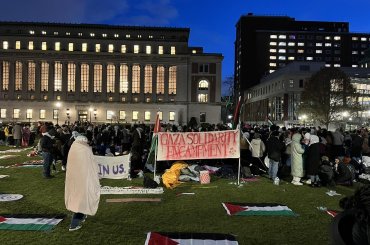
Carlos Latuff’s drawing of Khader Adnan (Via Gaza TV News)
By the time the Western press first noticed the hunger strike of Khader Adnan, the Palestinian baker whose struggle against Israel’s administrative detention policies captivated the world, the 33-year-old had endured 44 days without nourishment. A LexisNexis search shows that it took a week and a half after that first Agence France-Presse story for the Associated Press to publish on Adnan. CNN soon followed.
But in the early days of Adnan’s protest, and as the Western press largely ignored the story, a new kind of media activism was making waves and bringing awareness to his struggle. Led by online activists, many of them Palestinian, a sustained campaign on Twitter to publicize Adnan’s stand against administrative detention turned up the pressure on Israel. Perhaps the biggest coup for the activists came when Anne-Marie Slaughter, a former Obama administration official, condemned Adnan’s detention without charge on Twitter.
The online activism proved “the power of a different kind of media, one that uses corporate media’s silence to create a different kind of noise,” said Peter Hart, the activism director for Fairness and Accuracy in Reporting (FAIR), a media watchdog group. Hart authored a piece for the FAIR blog that chastised the corporate media’s silence on this “Palestinian Gandhi.” “It was a real moment where people created a kind of media sensation online that I think you have to be encouraged by,” he said.
As Adnan’s hunger strike continued into its 65th day, online activists managed to trend the hashtag #HungerStrikingfor65days at #1 worldwide for forty minutes. (For an explanation of Twitter trends, click here).
“Twitter has got millions of people to pay attention to Khader Adnan’s case online,” wrote Jalal Abukhater, a Jerusalem-based Palestinian blogger for the Electronic Intifada.
Abukhater authored a piece for Al Akhbar English that documented the “global protest” online in support of Adnan. Last Saturday, activists also trended #CoverKhader worldwide in a direct effort to shame mainstream media into covering Adnan. Activists also targeted Nicholas Kristof for his silence on Adnan despite a 2010 article opining for a “Palestinian Gandhi.”
According to statistics on the website Topsy, tens of thousands of people have mentioned Adnan’s name on Twitter over the past month, with many of the mentions coming well before the mainstream media covered the story.
The question of whether the online activism for Adnan played a direct role in convincing corporate media outlets to cover the story is a difficult one to answer definitively. Robert Mackey, the New York Times blogger who was the first NYT writer to cover Adnan, said that he first heard about the story elsewhere, and not on Twitter. “I dislike the use of Twitter to press journalists to cover events, because I use the social network to find reports or commentary on the news from bloggers, journalists and eyewitnesses,” Mackey wrote in an email. “Organized efforts to make certain subjects more prominent seems to make Twitter less useful to me by changing the signal to noise ratio.”
But Jillian York, a writer and the director of International Freedom of Expression at the Electronic Frontier Foundation, has a different take on the connection between social media campaigns and mainstream media coverage. In general,“you have this discussion, debate on social media which then parlays itself into campaigning of some sort which then explodes into media coverage,” York said in a phone interview. “A lot of the discussion last year [during the Arab uprisings] was about people organizing around social media. I actually argue that the real value of social media is getting international coverage, international attention to your cause.”
But even if the online activism didn’t lead directly to mainstream media coverage, it did, at least, shine a light on the silence on Adnan’s hunger strike from corporate media. This silence largely held until the climax of Adnan’s case, which culminated in a deal in which Adnan is to be released April 17 and not have his detention order renewed. Adnan has ended his hunger strike.
“The fact that these people didn’t write about it is an indictment of their previous supposed commitment to Palestinian nonviolence,” said FAIR’s Hart. “In a sense, their silence spoke more powerfully than one or two news articles. I think we learned something fundamental about the media, and we learned something fundamental about working around the media–deciding that if people tweet enough, and I know that sounds corny, but if you can do that and create kind of a tidal wave, maybe Tom Friedman is someone you don’t need.”



how many twitter tweets does it take to get a freedom fighter out of jail?
for the entity that incarcerates the freedom fighter, depends on how serious the risk of delegimization, should it ignore said tweets
if the risk is nil?
the incarcerated freedom fighter best prepare for a very long stay
but if the risk is great?
there’s the example of khader adnan
Keep up the pressure.